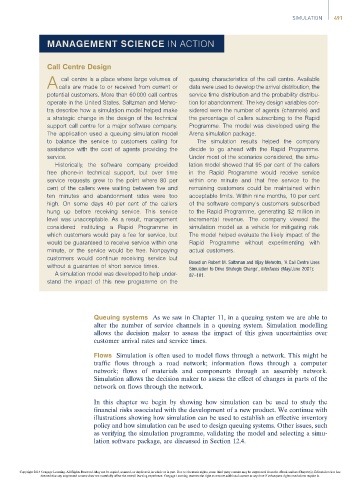Page 511 -
P. 511
SIMULATION 491
MANAGEMENT SCIENCE IN ACTION
Call Centre Design
call centre is a place where large volumes of queuing characteristics of the call centre. Available
A calls are made to or received from current or data were used to develop the arrival distribution, the
potential customers. More than 60 000 call centres service time distribution and the probability distribu-
operate in the United States. Saltzman and Mehro- tion for abandonment. The key design variables con-
tra describe how a simulation model helped make sidered were the number of agents (channels) and
a strategic change in the design of the technical the percentage of callers subscribing to the Rapid
support call centre for a major software company. Programme. The model was developed using the
The application used a queuing simulation model Arena simulation package.
to balance the service to customers calling for The simulation results helped the company
assistance with the cost of agents providing the decide to go ahead with the Rapid Programme.
service. Under most of the scenarios considered, the simu-
Historically, the software company provided lation model showed that 95 per cent of the callers
free phone-in technical support, but over time in the Rapid Programme would receive service
service requests grew to the point where 80 per within one minute and that free service to the
cent of the callers were waiting between five and remaining customers could be maintained within
ten minutes and abandonment rates were too acceptable limits. Within nine months, 10 per cent
high. On some days 40 per cent of the callers of the software company’s customers subscribed
hung up before receiving service. This service to the Rapid Programme, generating $2 million in
level was unacceptable. As a result, management incremental revenue. The company viewed the
considered instituting a Rapid Programme in simulation model as a vehicle for mitigating risk.
which customers would pay a fee for service, but The model helped evaluate the likely impact of the
would be guaranteed to receive service within one Rapid Programme without experimenting with
minute, or the service would be free. Nonpaying actual customers.
customers would continue receiving service but
Based on Robert M. Saltzman and Vijay Mehrotra, ‘A Call Centre Uses
without a guarantee of short service times.
Simulation to Drive Strategic Change’, Interfaces (May/June 2001):
A simulation model was developed to help under- 87–101.
stand the impact of this new programme on the
Queuing systems As we saw in Chapter 11, in a queuing system we are able to
alter the number of service channels in a queuing system. Simulation modelling
allows the decision maker to assess the impact of this given uncertainties over
customer arrival rates and service times.
Flows Simulation is often used to model flows through a network. This might be
traffic flows through a road network; information flows through a computer
network; flows of materials and components through an assembly network.
Simulation allows the decision maker to assess the effect of changes in parts of the
network on flows through the network.
In this chapter we begin by showing how simulation can be used to study the
financial risks associated with the development of a new product. We continue with
illustrations showing how simulation can be used to establish an effective inventory
policy and how simulation can be used to design queuing systems. Other issues, such
as verifying the simulation programme, validating the model and selecting a simu-
lation software package, are discussed in Section 12.4.
Copyright 2014 Cengage Learning. All Rights Reserved. May not be copied, scanned, or duplicated, in whole or in part. Due to electronic rights, some third party content may be suppressed from the eBook and/or eChapter(s). Editorial review has
deemed that any suppressed content does not materially affect the overall learning experience. Cengage Learning reserves the right to remove additional content at any time if subsequent rights restrictions require it.

